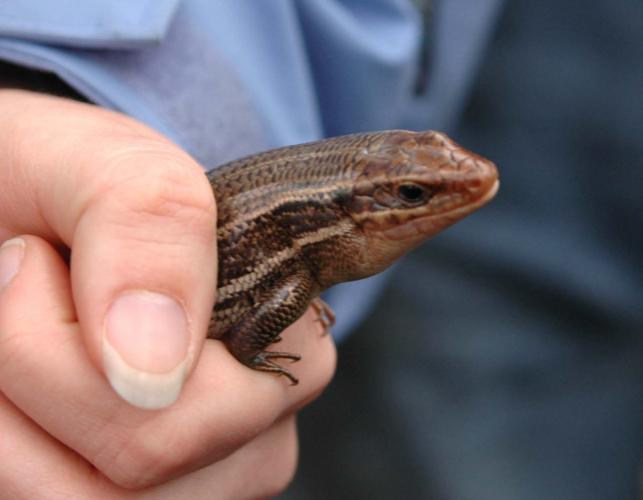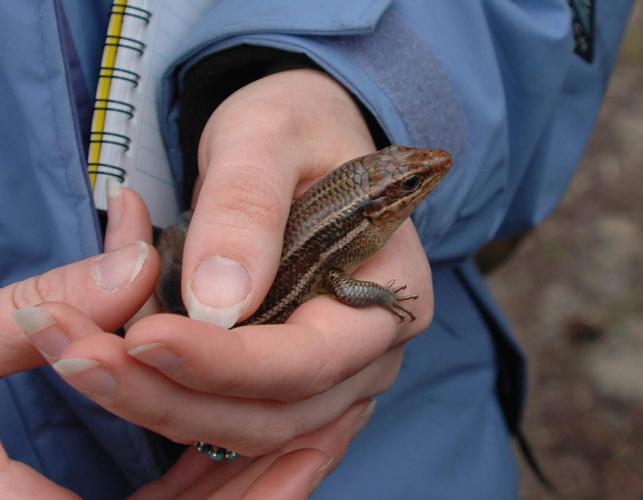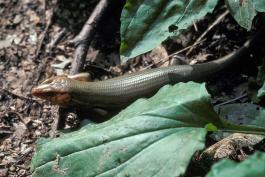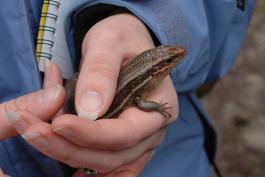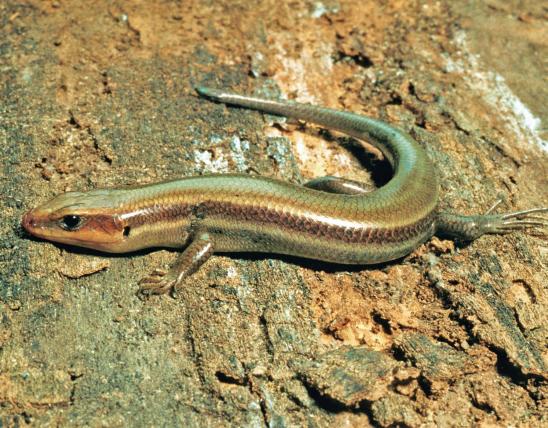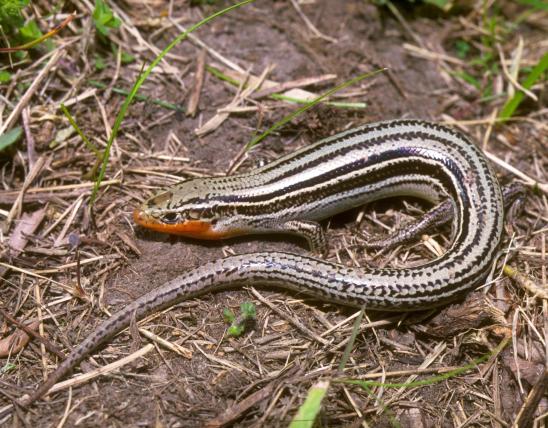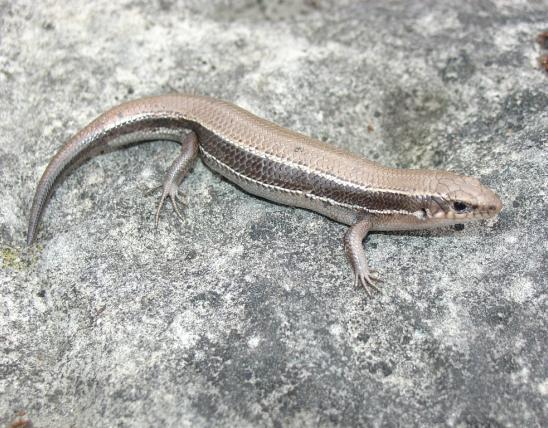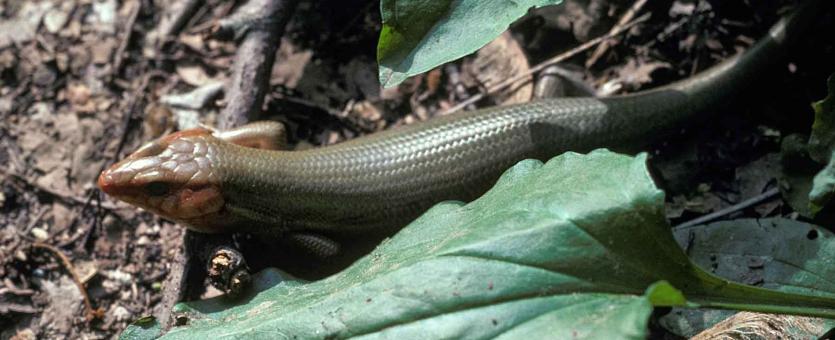
The broad-headed skink is a large, shiny, smooth-scaled lizard with a large, wide head. It lives in forest openings and occurs in the southern two-thirds of the state. The color varies a great deal depending on age and sex.
- Adult males are usually olive brown with few or no stripes along the head and sides, but during breeding season they develop a swollen, orange-red head (this explains the common name).
- Adult females are usually tan to brown, with light brown and dark brown or black stripes down the back and sides, with a wide, dark stripe down each side usually being most prominent.
- Hatchlings are jet black with five narrow yellow lines along the back and sides, with a bright blue tail. (Note that the juveniles of some other skink species also have black bodies with blue tails.)
Similar species: Five-lined skinks are very similar, though they do not attain as large a size (to only 5 to 8¾ inches in length). You can verify the identification by examining the scale patterns along the upper lip.
The broad-headed skink:
- Has 8 or 9 upper labial scales (not counting the single scale at the very front/center of the mouth, count the scales backward along the upper lip, up to and including the obvious large scale at the base of the jaw); also, counting from the front, the sixth upper labial scale is the first to contact the orbit of the eye (eye circle).
- Lacks or has only 1 or 2 small postlabial scales (these are either absent or quite small) (postlabial scales are ones that would be positioned in the space between the last, fairly large lip scale and the ear hole; contrast with the common five-lined skink, below).
- Has a maximum snout-to-vent length more than 3¼ inches. (It is generally larger than the common five-lined skink).
The common five-lined skink:
- Has 7 upper labial scales; also, the fifth upper labial scale is the first to contact the orbit of the eye.
- Has 2 postlabial scales (these scales are positioned, one on top of the other, in the space between the last, fairly large lip scale and the ear hole).
- Has a maximum snout-to-vent length less than 3¼ inches. (It is generally smaller than the broad-headed skink).
Adult total length: 6½ to 12¾ inches.

Found throughout the southern two-thirds of the state. Probable range extends as far north as Bates, Saline, Chariton, Macon, and Marion counties.
Habitat and Conservation
As with all Missouri lizards, the broad-headed skink is active during the daytime, mainly between April and October. Most of their time is spent in or near trees; of all Missouri's lizards, this one is most associated with trees. Broad-headed skinks typically live in forest openings. They hide in tree cavities, often many feet above the ground; they may use abandoned woodpecker holes or other cavities. They are also seen on old stumps, on large logs, or around run-down farm buildings. In cities, they may be locally abundant and seen basking in the sun on firewood piles, large tree trunks, old railroad ties, rock gardens, and wooden decks.
As with most other skinks, the tail breaks off easily, allowing these lizards to escape predators. Very little blood is lost when this happens, and a new tail eventually grows back later. The regrown portion of the tail will be shorter than the original and is a drab gray color.
Food
The diet of broad-headed skinks includes insects, spiders, land snails, small lizards and their eggs, and snakes, as well as baby mice.
Status
One of the more frequently encountered skinks in Missouri.
Life Cycle
Courtship and mating apparently take place in late April through early June. Females begin brooding their clutch of eggs about 30 days after mating. Nests are usually located in a rotting stump or log, within a tree cavity, under the bark of a rotting log, or in a pile of rotting lumber.
Clutches containing more than 10 eggs may indicate a communal nest, into which eggs have been deposited by more than one female. Such communal nesting is sometimes called "egg dumping."
The broad-headed skink's large body size allows the females to produce more eggs than other species of skinks, and a single female may lay 6–25 eggs. The female remains with her eggs until they hatch in July or August.
The strikingly different coloration of juveniles is believed to be a way of protecting them from territorial males who, during breeding season, might attack them if they looked like adult broad-headed skinks.
Broad-headed skinks become sexually mature at about 2 years of age and likely live between 7 and 8 years.
Human Connections
This harmless but large lizard will certainly try to bite a person’s hand when captured, but the bite seldom breaks the skin. The bite is a little painful, but it is not dangerous.
Old-time Ozarkers called skinks "scorpions," but they are completely unrelated to those spider-like creatures and are certainly not venomous. But that colorful nickname indicates that Missourians have long been intrigued by these fascinating and harmless lizards. (It's amusing to note that Ozark folklorist Vance Randolph reported that true scorpions were often referred to as "stingin' lizards" in Ozark dialect.) The "scorpion" name might have originally been applied to certain types of lizards because some species curl and waggle their tails, rather like a scorpion does, in order to fool a predator into targeting the expendable, detachable tail instead of aiming at the lizard's indispensable head.
The odd-sounding name "skink" (and the family name, Scincidae) came to us from Greek and Latin words (respectively, skinkos and scincus) that were the original ancient names for particular species of lizards native to those Mediterranean regions.
Ecosystem Connections
Like most lizards, this species preys on insects and other small targets and is preyed upon by larger predators, including mammals and birds. This species often makes its home in abandoned woodpecker cavities, an example of the many interconnections in nature.
The skinks (Scincidae) are a large family of lizards with species on nearly every continent and many oceanic islands. There are over 1,580 species worldwide, representing about 115 genera. The smallest species may be only 3 inches long; the largest (in Australia) may reach a length of over 2 feet. Most species have smooth, overlapping scales and live either on or under the ground. Five genera with about 15 species occur in the United States. A few nonnative species have been introduced into southern Florida. Missouri skinks are represented by two genera with a total of six species and one additional subspecies. All our skinks can quickly break off their tails if grasped by a predator.

